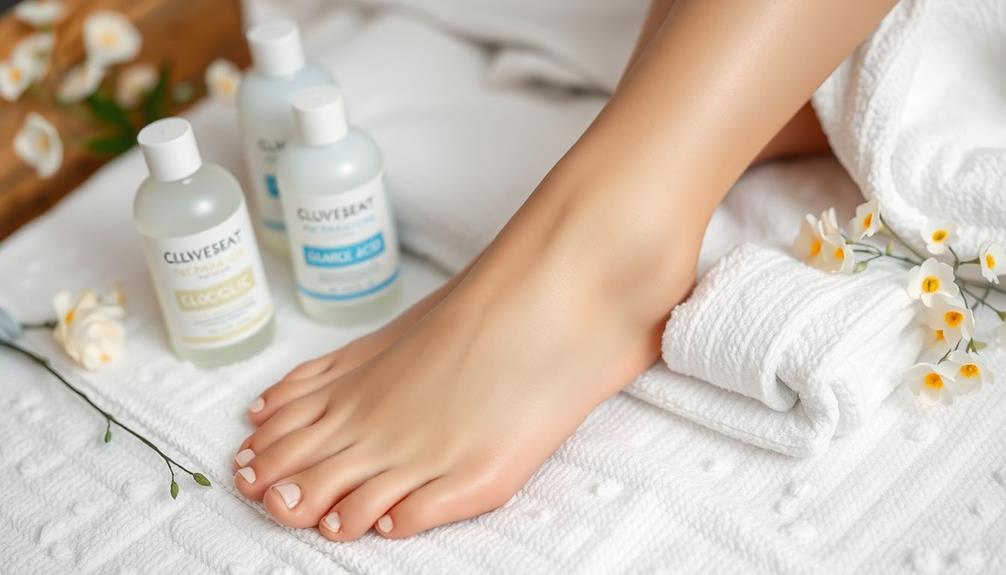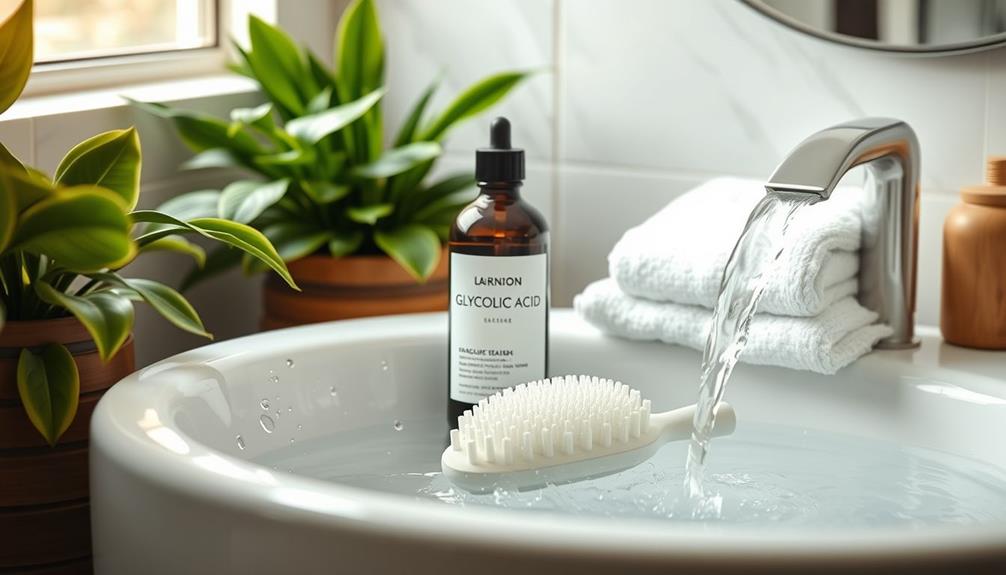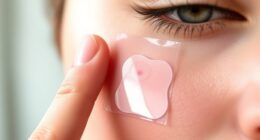Glycolic acid's your secret weapon for achieving smooth, soft feet. This powerful alpha hydroxy acid gently exfoliates and breaks down the bonds holding dead skin cells together. You'll start feeling the difference within hours of applying it. Just soak a cotton pad with a glycolic acid solution and swipe it over clean feet. After that, lock in moisture with a nourishing cream and consider wearing socks overnight for better absorption. Regular use keeps dry, cracked skin at bay. Curious about more tips and tricks to make this miracle ingredient work wonders for you? There's plenty more to explore!
Key Takeaways
- Glycolic acid effectively exfoliates rough skin on feet, promoting smoothness and softness.
- Regular use prevents dead skin buildup, reducing dryness and cracking.
- Results can be noticeable within two hours of application, enhancing overall foot appearance.
- Follow up with a nourishing moisturizer for optimal hydration and results.
What Is Glycolic Acid?
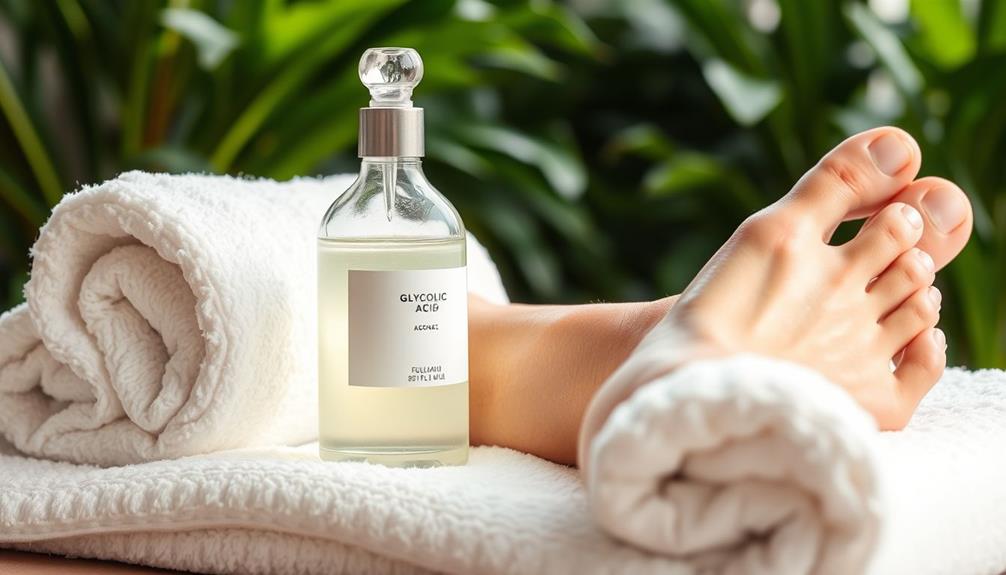
Glycolic acid, derived from sugar cane, is an alpha hydroxy acid (AHA) that effectively exfoliates your skin by breaking down the bonds between dead skin cells. This powerful ingredient is a game-changer in your skincare routine, particularly for areas like your feet, where thick, rough skin can build up over time. By incorporating glycolic acid into your regimen, you can promote smoother, healthier skin.
For enhanced skin health, consider complementing glycolic acid with essential oils for skin care that can provide additional hydration and nourishment.
You'll find glycolic acid in various skincare products, such as cleansers, toners, serums, and moisturizers. It penetrates the skin deeply, helping to dissolve layers of dead skin cells and revealing the fresh, new skin beneath. Regular use of products containing glycolic acid can lead to significant improvements in skin texture, making your feet feel softer and more comfortable.
Many dermatologists recommend glycolic acid not just for its exfoliating properties but also for its ability to enhance overall skin appearance. By encouraging skin cell turnover and boosting collagen production, glycolic acid helps you achieve a radiant, youthful look.
Benefits for Dry Cracked Feet
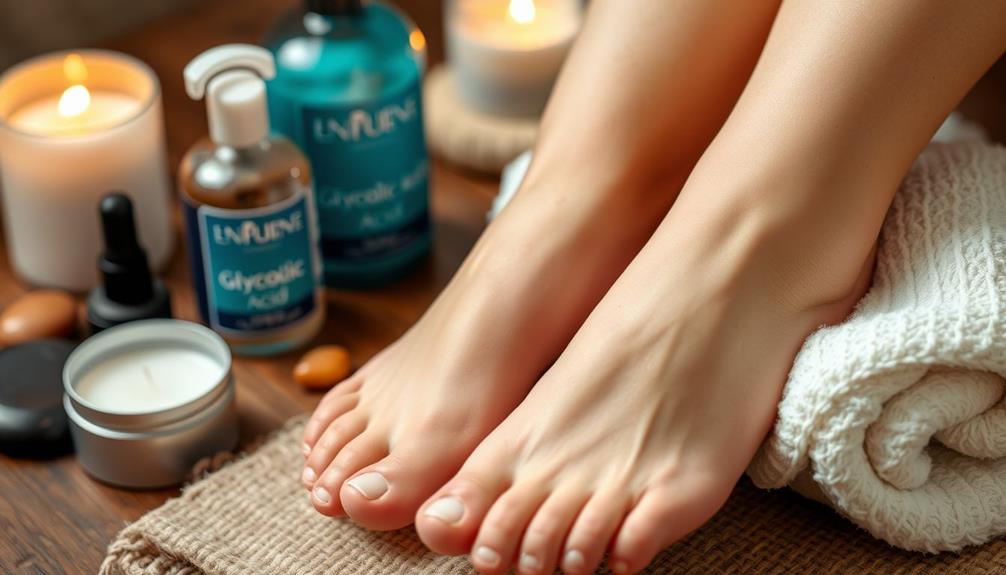
If you've got dry, cracked feet, incorporating glycolic acid into your routine can offer remarkable benefits by effectively exfoliating and smoothing the rough skin. This powerful ingredient works by breaking down the bonds between dead skin cells, allowing for a smoother texture and softer appearance.
Dermatologists often recommend glycolic acid products, like The Ordinary's Glycolic Acid 7% Toning Solution, for treating dry cracked feet, and you might notice results in as little as two hours. Additionally, aromatherapy techniques can complement your skincare routine, providing relaxation and enhancing the overall experience of self-care.
Regular use of glycolic acid, ideally once or twice a week, helps prevent the buildup of dead skin, reducing the chances of cracking and improving overall skin texture. You'll love the way it exfoliates, leaving your feet feeling revitalized.
To maximize the benefits of glycolic acid, follow up with a nourishing moisturizer. This combination enhances moisture retention, further softening the skin. Many users report significant improvements in hydration and texture over just a few nights.
Application Process and Tips
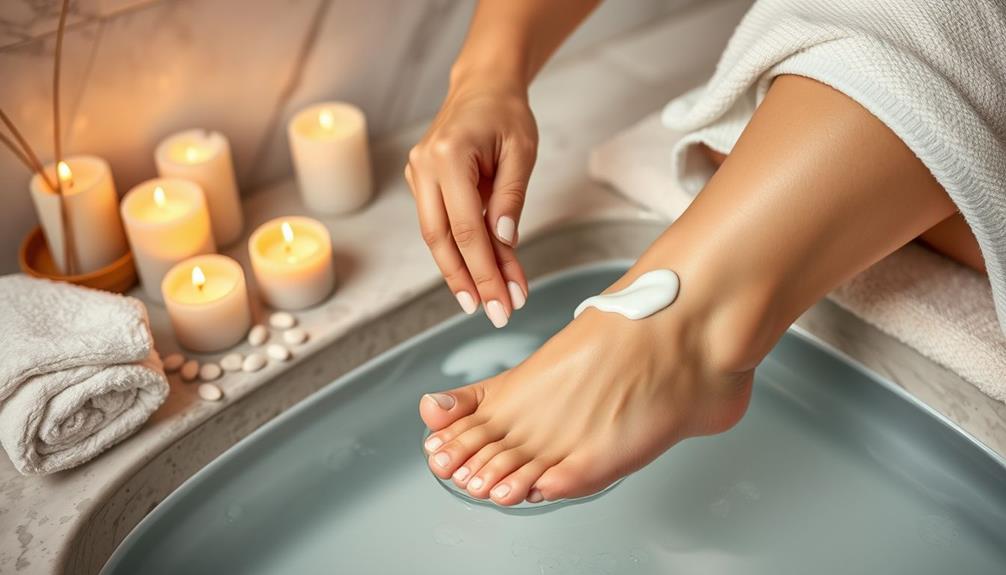
To effectively apply glycolic acid, soak a cotton pad with the solution and gently swipe it across your dry feet for ideal exfoliation. This application process helps slough away dead skin cells, revealing smoother skin.
For best results, it's important to guarantee that your feet are clean and free from any strong scents or irritants, as cats tend to be sensitive to certain smells, such as citrus or strong fragrances 10 smells cats hate.
After applying the glycolic acid, it's vital to follow up with a generous amount of moisturizing cream, like Flexitol Overnight Foot Cream, to nourish your skin and lock in moisture.
For enhanced results, consider wearing thick socks overnight to improve the absorption of both the glycolic acid and the moisturizer. This simple step can amplify the benefits, leading to noticeable improvements in skin texture within just a few nights.
Safety and Precautions
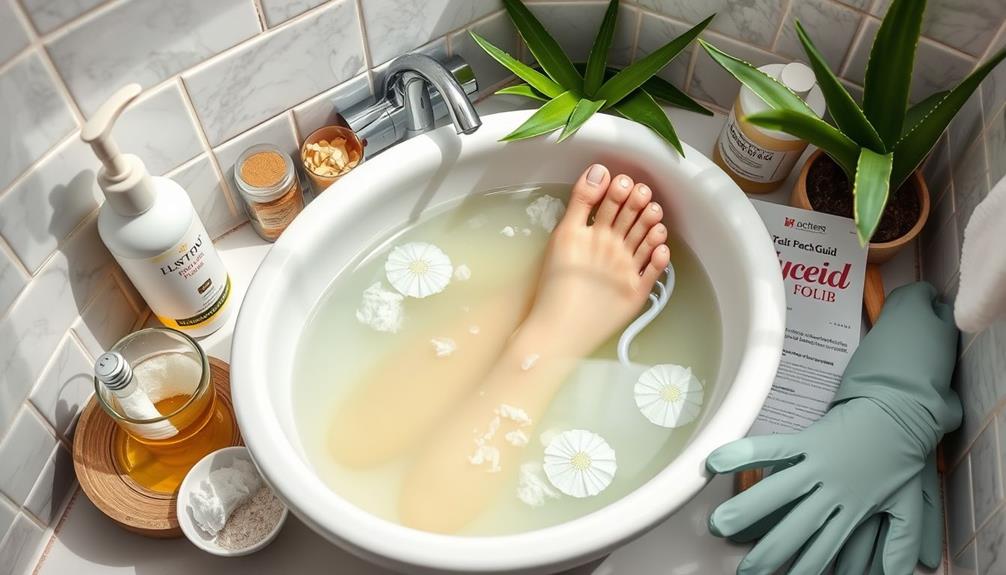
Using glycolic acid on your feet can be effective, but knowing the safety precautions is important to avoid potential skin issues. Here are some key points to take into account before you start:
| Precaution | Recommendation | Why It Matters |
|---|---|---|
| Patch Testing | Always perform a patch test first. | To check for adverse reactions. |
| Frequency of Use | Limit to once or twice a week. | Reduces the risk of irritation. |
| Consult a Dermatologist | If you have dry or broken skin. | To explore safer alternatives if needed. |
Mild skin irritation can happen, especially if you're new to glycolic acid. Always follow product instructions carefully. If you have sensitive skin or underlying health conditions like diabetes, consult a dermatologist before using these products. Pregnant women should also seek medical advice. After applying glycolic acid, make sure to follow up with a nourishing moisturizer to keep your skin hydrated and maintain safety. Taking these precautions will help you enjoy the benefits of glycolic acid while minimizing any risks.
Community Feedback and Trends

The vibrant community surrounding glycolic acid for foot care is buzzing with enthusiastic feedback and shared experiences, particularly on platforms like TikTok. With the hashtag #dryfeet amassing 129 million views, it's clear that people are keen to learn how glycolic acid can help smooth and soften their feet.
Influencers and dermatologists are joining the conversation, highlighting its effectiveness in transforming dry feet into a more hydrated and appealing state. Additionally, those interested in holistic approaches to skincare may find that incorporating mindful practices can enhance the overall results, as seen in mindful eating practices that improve overall well-being.
Many users have reported noticeable improvements in foot texture after just a few applications, fueling the trend's rapid growth across social media. This reflects a broader awareness of proactive foot care, encouraging individuals to adopt effective skincare practices.
Community engagement plays a significant role in this movement, with users sharing tips and encouraging consistent application for ideal results. By exchanging their experiences, they motivate one another to incorporate glycolic acid into their routines, fostering a supportive environment focused on achieving beautiful, healthy feet.
As more people join the conversation, the trend not only promotes foot care but also strengthens community bonds around shared skincare goals.
Conclusion
Incorporating glycolic acid into your foot care routine can transform your dry, cracked heels into soft, smooth surfaces, much like a sculptor refining a rough stone into a masterpiece.
With proper application and care, you'll enjoy the benefits of this miracle ingredient in no time.
Remember to follow safety tips and listen to your feet's needs.
Embrace the journey to healthier feet and step confidently into your day, feeling refreshed and revitalized!
